The practice of tea started in China during the 8th Century under three different dynasties and was cultivated and used in a different form. The three different forms were:
- Using salt, butter, and other dairy products,
- Whipped powder tea in water,
- and extracted tea by marinating it in hot water.
By the time the 9th century approached, Japan became connoisseurs to tea and started tea cultivation in the suburbs of Kyoto. During the beginning of the 9th century, although tea became known within the culture, its popularity died down over time until a Priest, who studied Zen Buddhism, brought it back to Japanese culture in 1191.
After the Zen Temples and the Civil War, Tea was made by professional servers and meant to be placed in front of utensil shelves, in small rooms or at the end of corridors, and was then given to Masters and guests. There was an intimacy of nature and subtle aesthetics connections of drinking tea that formed the basis of these tea ceremonies. These tea rooms and tea houses were a symbol to bring the rise of spirituality within the Japanese people and the important aspect of that is the combination of the ceremony and the architecture. The chadō (Japanese Tea ceremonies) started the development of tea drinking and because of that, tea cultivation expanded and became the top practices done within the Japanese culture.
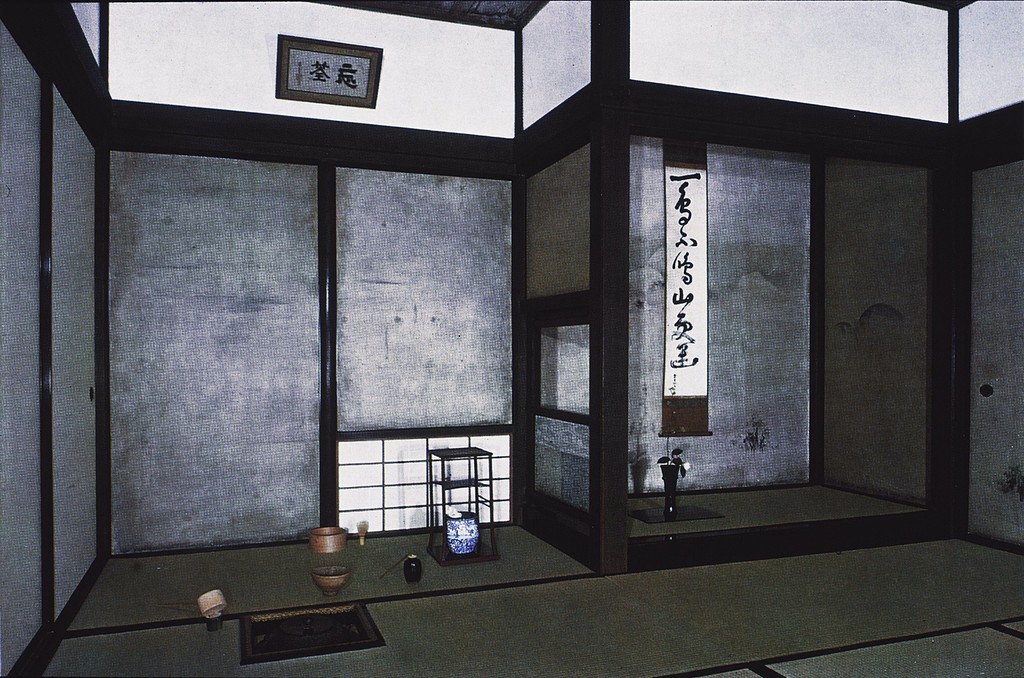
Date: 17th-19th C. (Edo Period)
Location: Kyoto (Japan)
This image portrays a normal tea room where tea ceremonies are held and each architectural features has a meaning to these spiritual moments Japanese people use to get together to connect more with nature.
Tea Ceremony Room
In a tea room, there is a simplicity that needs to be expressed throughout the entire room to form these tea ceremonies. For example, on the image there are utensils are the floor; those utensils are used to prepare the tea for a spiritual harmony with nature. There is also a vase with flowers to add more to the Japanese aesthetic, which is called the wabi sabi. Wabi Sabi is translated to an aesthetic sense in Japanese art emphasizing quiet simplicity and the search of imperfection within the natural circle of life. Those utensils and flowers has a purposeful meaning to a tea room, to bring a simplicity to commence the connection of nature during the ceremony.
Apart from the utensils and flowers that are placed in these tea rooms and their connection to the meaning of wabi sabi, there is also an architectural aspect to these rooms, which in the architectural form, it would be called chashitsu. A chashitsu is a Japanese words that is used to called a tea room. Chashitsu has shoji windows, sliding doors of wooden lattice covered in translucent washi paper, tatami mats, and an alcove. The tea room in the image above has sliding doors for people to come in and out and tatami mats where people sit during the ceremonies. There isn’t a wooden lattice but there is a small window like that may be another form of a lattice to fulfill that architectural structure of a tea room.
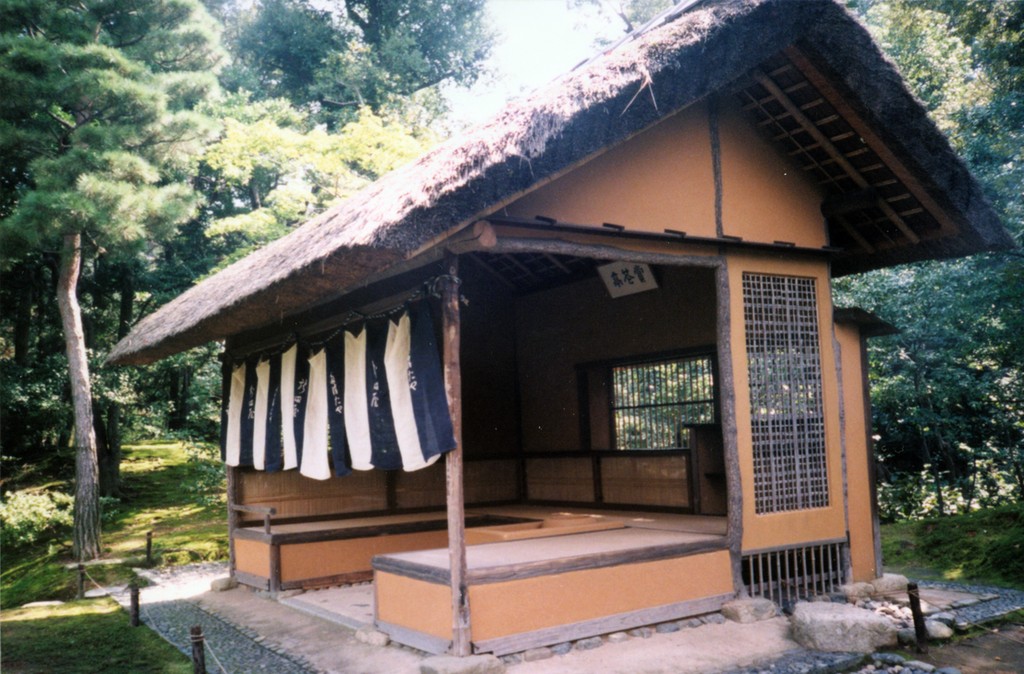
Date: Originally ca. 1620, rebuilt 1640-55
Repository: Shokintei, Katsura Palace
Creator: Kobori Enshū (Japanese tea master, designer, 1579-1647)
Chashitsu
In this chashitsu, you can see the tatami mats above the platform, the open space meant to bring the spirituality of nature closer, the wooden lattice that are on two sides of the chashitsu, and an alcove to show the opening of the tea room. There aren’t utensils within the structure because it wasn’t photograph during a ceremony, however, when there is one, utensils will be brought out to prepare the tea.
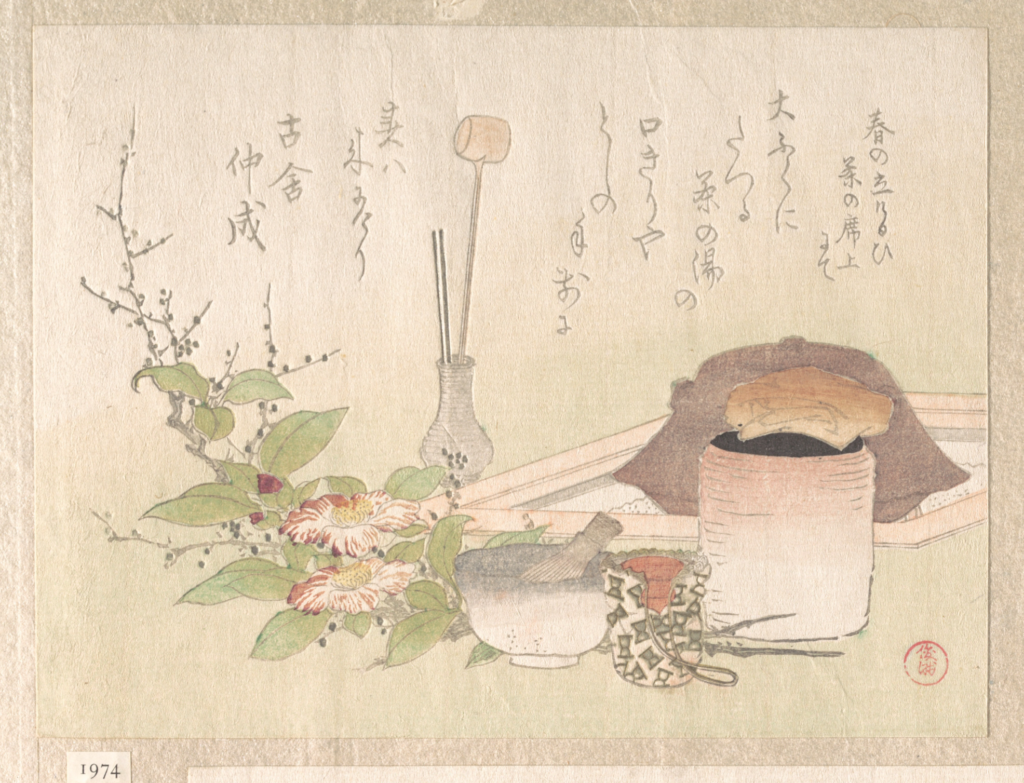
Artist: Kubo Shunman 窪俊満 (Japanese, 1757–1820)
Period: Edo period (1615–1868)
Medium: Woodblock print (surimono); ink and color on paper
Dimensions: 5 7/16 x 7 1/4 in. (13.8 x 18.4 cm)
Wabi-Sabi
As I have mentioned in the “Tea Ceremony Room”, there are utensil shelves used during each tea ceremony and in this image above, are utensils used to mix the tea and then is placed beside a branch of camellia and a flower that blooms at the end of winter and beginning of spring. This is the aesthetic simplicity I spoke about earlier when explaining what wabi sabi meant and when I was discussing what a tea room usually holds within each ceremony.
Therefore, these ceremonies creates a form of fragility within the practice in both architecture and spirituality wise. While utensils and the structure of these tea rooms (chashitsu) holds a huge role on these tea ceremonies, the location of where these tea houses are place matters equally.
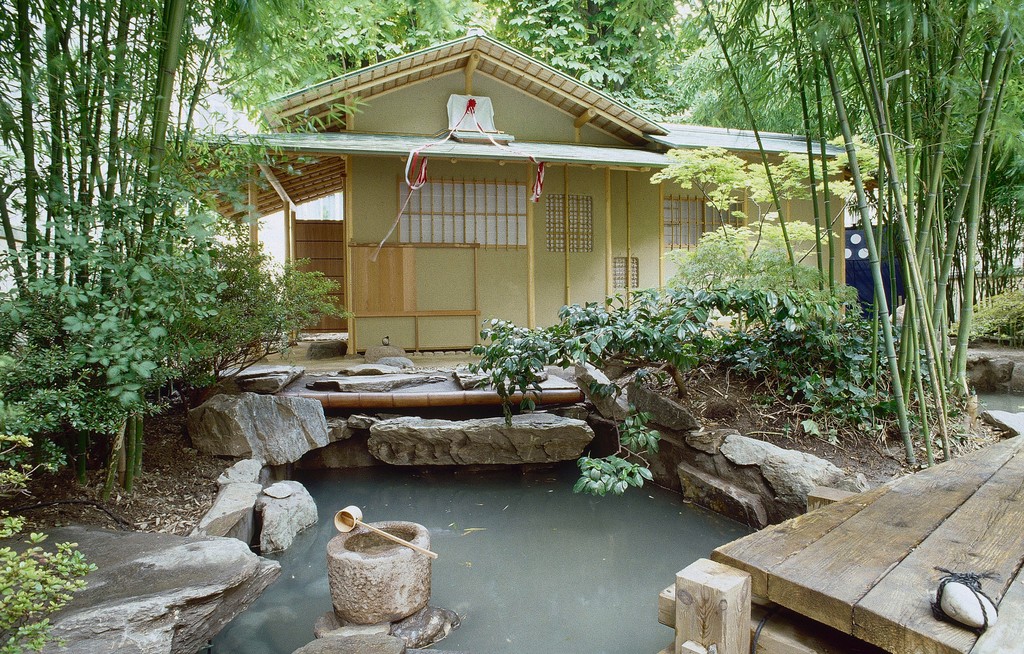
Creator: Architect: Masao Nakamura; gardens: Robert Bazelaire; master carpenter: Takaaki Yamamoto
Repository: Musée Guimet, Paris, France
Date: 2001
Nature
The structures within each tea house are purposefully placed in unusual locations due to the fact of the avoidance of symmetry and repetition within structures. In addition, the entrances were doubled and each has its own purpose, one is for the noblemen and the other is for nijiriguchi (crawling-in entrances) with a water basin to allow others to enter. Although the interior holds an important aspect to tea ceremonies, the garden also holds importance. Chashitsu usually contain a bunch of trees, a river or pond, and with flowers as some sort of ritual for the entrance to the tea houses and the commencement of tea ceremonies. These gatherings outside where the sound of nature, listening to birds, is the practice before entering the tea rooms and in Japanese culture uses the walk on stones towards the tea rooms to be the start of the performance of each ceremony.
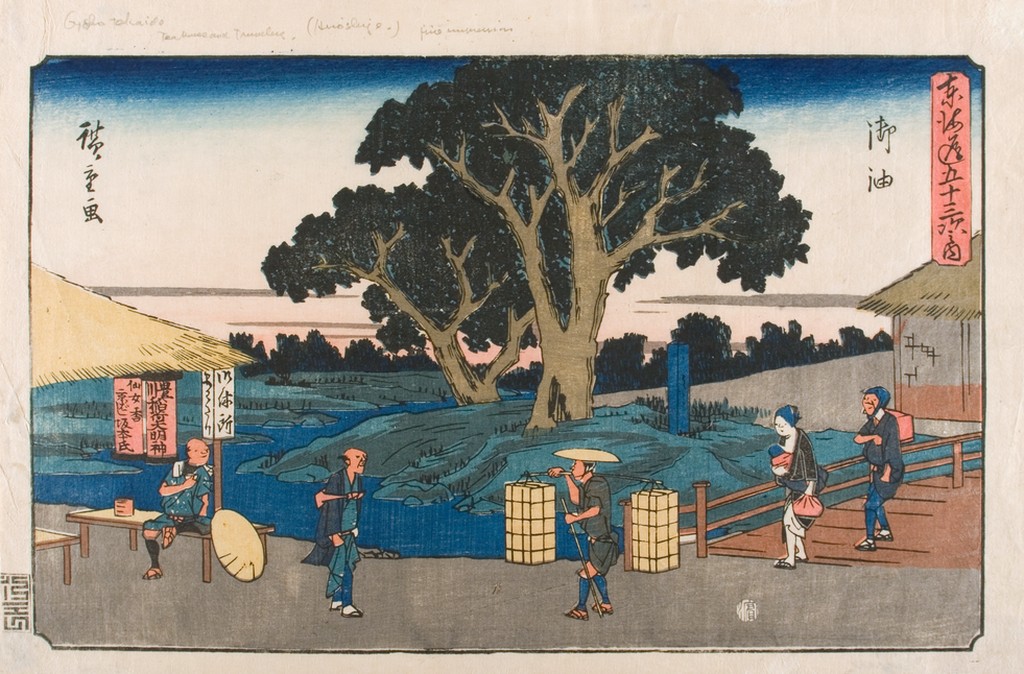
Creator: Utagawa, Hiroshige I
Artwork: Printmaking with color woodcut
Dimensions: 9.25 x 13.75 in.
Repository: Wriston Art Galleries, Lawrence University, Appleton, Wisconsin
Period: Edo
Date: 1840s
Stone Path/Bridges
Chashitsu started to be used during the Edo Period, which are usually located in Japanese gardens, private homes, museums, and parks. Here you can see the garden where the tea ceremony is located and the connection the architect wanted to have with the tea house and nature. Here is also a bridge, or in other cases a stone path is used, leading to the tea houses, seen as a spiritual entrance and its seen with people walking towards the wooden structure of a chashitsu.
All of these images connect with each other because of how the traditional tea house (chashitsu) in Japanese culture, including wabi sabi aesthetics, is portrayed based on the architectural forms and the art work given to show what an actual tea ceremony looks like. The influence from Zen transforming to Japanese chashitsu and wabi sabi is a kind of performance for art production through the form of bodily poses and brings trainings and courtesy of Japanese people’s daily and social life.
Bibliography
https://library.artstor.org/#/asset/ARTSTOR_103_41822003455902
https://library.artstor.org/public/SS33119_33119_15146242
https://www.metmuseum.org/art/collection/search/54559?ft=tea+ceremonies&offset=0&rpp=40&pos=16
https://library.artstor.org/#/asset/AWSS35953_35953_30947459
https://library.artstor.org/#/asset/AWRISTONIG_10313351207
https://www.ippodogallery.com/blog/90-the-chashitsu-tea-room/